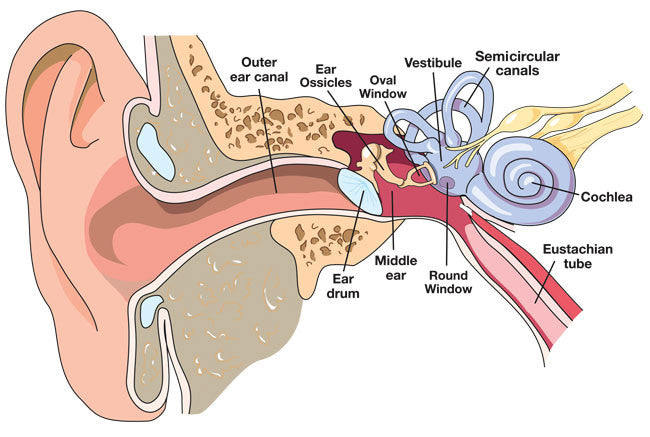Our ears are very important as they not only handle our ability to hear but also take care of our balance as well so it is vitally important that we care extra care of them whilst diving as they are prone to damage if abused.
Know Your Ears
For those that don't know much about their ears, each one is divided up into three basic sections; outer, middle and inner:
- The outer ear is everything on the outside of the body including the ear canal. The eardrum is what separates the outer and middle ear.
- The middle ear is the bit we equalise whilst diving via the Eustachian tubes which connect the middle ear to the throat. Between the middle and inner ear are two openings covered by thin membranes - the round and oval windows. These are important to transmit sounds into the inner ear.
- The inner ear is located in a complex cavity called the bony labyrinth. The inner ear is important for hearing and also balance while moving or stationary.

What Happens When We Equalise Our Ears
The middle ear is essentially dead air that is equalised by moving air through the Eustachian tube which is normally closed until certain actions such as swallowing cause it to open and equalise the pressure.
As we descend the air in the middle ear is compressed but there isn't enough air pressure in the throat to adequately force air up the Eustachian tube. By pinching our nose and forcing air into our throat and mouth we force the tube open and manually equalise the pressure.
Equalisation during ascent is often automatic as the air in the middle ear expands and forces it's way out of the tube to prevent over pressurisation. The act of swallowing also helps the process.
Equalising Methods
There are actually quite a few equalising techniques but none of them will work effectively if you don't equalise often enough. As you descend the pressure difference in the middle ear can actually force the Eustachian tube shut making equalisation impossible and painful which is why it is so important to do it regularly during the descent.
If equalisation becomes difficult you should immediately stop your descend and ascent a metre at a time until you are able to equalise properly before continuing with your descent.
The most commonly used equalisation method used by scuba divers is the Valsalva Manoeuvre which is where you exhale against a pinched nose and sealed mouth. This method has one issue that we mentioned above, it will only work when performed frequently and before the pressure difference becomes so great that you are unable to force air up the tube. It is also important to remember not to be too forceful with the exhale pressure to avoid damage to the delicate ear components.
There are other techniques that other divers find helpful when equalising their ears:
- Pinch the nose and swallow
- Pinch the nose, blow and swallow
- Tense your throat and push your jaw forward
- Close off the vocal cord, pinch your nose and make the sound of the letter “K”. This method is used by freedivers as it very effective, requires significantly less wasted air and energy to perform but does take some practice.
Beginners Equalisation Tips
It is quite common for new divers to experience problems equalising. You've got some many new skills to remember that you can often be stressed during your first few dives and that can have a big effect on being able to equalise your ears because your muscles are tensed.
Practice different techniques gently on landing until you know you have your preferred method absolutely right so when you get in the water it is one less thing to have to think about. Go slow and equalise often, other divers will be happy to wait for you as everyone has had this problem at some point.
Additional Equalisation Tips
Even experienced divers can have problems so here are a few more tips to help alleviate the issue:
Equalise often
Get things started before you start the dive. Equalise a few times before you get in thew water and again on the surface. During the descent don't wait for the pressure differences to build up. Equalise with every exhale if you need to, you can't do it too often after all.
Go Feet First
Going feet first will prevent any additional fluids moving to your head and applying extra pressure which might make equalising harder.
Avoid Irritants
Cigarette smoke, exhaust fumes and exposure to allergens can increase swelling and congestion around your Eustachian tubes and make it difficult to clear. Try to breathe fresh, clean air just before a dive.
Pay attention to what your body is telling you
Your body knows best and if is isn't feeling too good then don't go diving. Colds, allergies and other similar illnesses can all block up or irritate the air passages and Eustachian tubes. If you force your way down you might end up doing damage to your ear for find yourself in the predicament of not being able to equalise on the way up if the tubes block.
Keep Warm
Keep yourself warm and drink a hot drink before the dive as it might help to loosen the tissues up enough for you to enjoy the dive.
What to do if you still have problems
First off you should probably seek the advice of a specialist doctor that understand the problems and issues that can be associated with diving.
There are also special masks such as the Pro-Ear Mask that incorporates cups that seal over the ears and are joined to the main section of the mask so that as you equalise the pressure in your mask the external pressure around your ears is also equalised.








